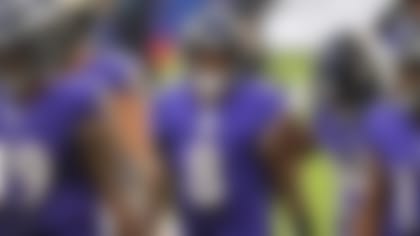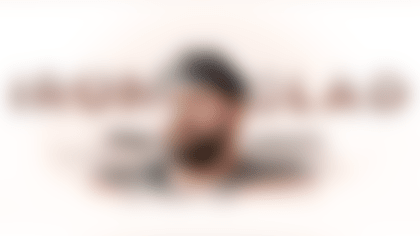By Judy Battista | Feb. 1, 2021
TAMPA, Fla. -- In hindsight, last year's NFL Scouting Combine was a miracle of fortuitous timing and very good luck. The carnival of hundreds of college players, media members, fans and NFL coaches and general managers -- all jammed into Indianapolis hotels and the convention center for interviews and 40-yard dashes -- ended in the first days of March. Even then, many of the people gathered there kept one eye on wild stock-market fluctuations, just as team owners and the NFL Players Association scrambled to finish negotiating a new collective bargaining agreement.
As intense as those days seemed then, they were unquestionably the quiet -- the last normal NFL event -- before the real storm hit. Little more than a week later, COVID-19 announced itself to the nation when, within hours of each other, the NBA stopped its season after Utah's Rudy Gobert tested positive and Tom Hanks revealed he was infected.
The tragedy of the pandemic has been immense and the tumult it has caused unending. The NFL was lucky to have just begun its offseason when it struck, but its schedule, and immediate future, were thrown into flux like virtually every other business in the United States.
Within days, the live draft planned for Las Vegas was off and travel for free-agent visits was forbidden. The offseason workout program, which was to have begun in early April, was indefinitely postponed.
But as schools, stores and workplaces shut down and the country largely screeched to a halt, the NFL kept free agency on the calendar as scheduled for mid-March. That was the first indication of the philosophy that would guide the league for the entire season, as it navigated the pandemic to conduct business and a contact-intensive sport as close to normal as possible: If it can be done safely, then keep going.
To pause it if it was not absolutely necessary for medical reasons -- during the offseason and then when the games began -- would have opened up an even more daunting question: With so much about the course of the virus changing constantly, when would be the right time to re-start?
The NFL ultimately constructed multitudes of contingency plans, but the goal all along was to never break the glass in case of emergency. Who knew, after all, when the emergency would end?
"We don't know what we're waiting for," said Dawn Aponte, the NFL's senior vice president of football operations and chief football administrative officer, of the thinking as the league started to make plans. "When it began, it was: How am I going to last two weeks at home? Then that turned into two months. We just needed to start preparing."
They did, with an ever-evolving set of protocols to govern testing, contact tracing, travel, meals, meetings and practically every other thing a football team does.
When the schedule was first released in May, it seemed aspirational more than anything, the expectation that it was written mostly in pencil. That the NFL has gotten to the doorstep of its championship game on schedule, and with a positive test rate well below local and national figures, is an unquestioned success and the result of a monumental, months-long undertaking that consumed virtually every part of the league, turning athletic trainers into infection-control officers, lawyers into contact tracers, former coaches into logistics advisors, and forcing everyone to nervously check their phones in the middle of the night for test results.
Here are the moments, the people and the decisions that got the NFL safely through its road to Super Bowl LV.

THE PANDEMIC HITS
The entire offseason was shaped by the NFL's attempts to work around the first weeks of the pandemic and what would have been the two biggest developments in any other year were quickly overshadowed by the news beyond the NFL:
- On March 15, players voted to ratify the new CBA -- by a margin of just 60 votes. The deal runs through the 2030 season and added two wild-card teams to the playoffs starting this season, with a 17th regular-season game likely beginning in the 2021 campaign.
- Tom Brady, who had bid farewell to New England in a social-media post just days earlier, signed a two-year contract with the Tampa Bay Buccaneers on March 20.
The NFL's own work-from-home order began March 25, after Commissioner Roger Goodell instructed all teams to shut their facilities to all but players receiving ongoing medical treatment and a few other essential employees. All other business was to be done remotely.
"I thought, It's March -- by the time we hit August, we should be in much better shape," Giants President John Mara said last month. "Obviously, that didn't occur."
Jaguars linebacker Joe Schobert had a different outlook: "I can think back to March and I wasn't sure the season would start on time."
Inside the players' union, the conversation around this time was simple: Should there even be a season? With the country shut down, unemployment soaring and people dying, one non-player with knowledge of the NFLPA's thinking at the time said there were concerns about if playing a season was the moral and ethical thing to do. And if it was, could it be done safely?
In April, the NFLPA drafted a memo of understanding that essentially bound the union and the league into making decisions together about how the season would proceed. It was a recognition that the fates of both sides were tied together and ultimately helped avoid the public fighting over money that plagued other sports leagues.

NFL GOES VIRTUAL
In mid-April, the NFL -- like everyone else -- became very familiar with Zoom. The offseason program, usually the first-time coaches and players can gather for meetings and workouts, went online and stayed that way throughout the summer, cancelling OTAs and minicamps. Starting April 20, clubs were allowed to have virtual classroom sessions and workouts. Teams shipped $1,500 worth of equipment to each player for virtual workouts because most gyms were closed. That supplemented the home-grown workouts players had already constructed. Players purchased Peloton bikes, ran hills in their neighborhoods, borrowed the keys to their old high school gym and did push-ups and sit-ups in the garage.
"You kind of go back to what life was like for me as an athlete before I had a world-class facility," Vikings tight end Kyle Rudolph said at the time.
Perhaps not surprisingly, players loved not having to return to their teams during the offseason, and union president JC Tretter is already advocating for at least some of the offseason reductions to become permanent.
And the draft -- the second biggest event on the NFL's calendar -- left Las Vegas and moved into Commissioner Goodell's basement. With in-person contact verboten, the NFL pulled off a technical marvel, linking teams and players and cameras for a three-day draft that was intimate and personal.
This was football mixed with HGTV. Chargers general manager Tom Telesco's surfboard was fun, everybody wanted Kliff Kingsbury's house and to know more about what Mike Vrabel's kids were doing, Brian Flores' young sons celebrated while dad was still on the phone conducting business, Goodell lounged in his favorite leather chair. And it was such a big hit that you can expect the NFL to borrow some elements of this draft for future ones. Coaches and general managers, who had expressed the most reservations about whether there would be glitches that would make it difficult to make picks, grew so comfortable with the format that their children -- and in Bill Belichick's case, his dog, Nike -- became part of their home war room.
"It's an adjustment, and it's different," Goodell said in an interview after the first round was over. "You don't compare it to the other ones. It was really cool."
On May 19, teams were allowed to reopen their training facilities, although only a handful of employees could go in at a time and there were strict social-distancing rules in place. Coaching staffs were allowed to return a few weeks later, but all offseason work remained virtual. No players could visit team facilities, which meant new coaches met their teams for the first time when training camps opened. In the meantime, Brady, with no other opportunity to get to know his new teammates, organized his own workouts with them at a closed private prep school in Tampa.

PLAYERS EXERT THEIR POWER
The May 25 killing of George Floyd while in police custody in Minneapolis set off worldwide protests of police brutality and systemic racism. And it inspired a video made by star NFL players, including Patrick Mahomes and Deshaun Watson, that challenged the league to do more and atone for its own mistakes in handling player protests, including those conducted by Colin Kaepernick four years earlier.
The video, released June 4, began: "It's been 10 days since George Floyd was brutally murdered. How many times do we need to ask you to listen to your players? What will it take? For one of us to be murdered by police brutality?"
It concluded with a plea: "So, on behalf of the National Football League, this is what we, the players, would like to hear you state: 'We, the National Football League, condemn racism and the systematic oppression of Black people. We, the National Football League, admit wrong in silencing our players from peacefully protesting. We, the National Football League, believe Black lives matter.' "
The next day, Goodell responded in a video he recorded at his home, surprising even team owners who did not know of his plan to address the players.
"We, the National Football League, condemn racism and the systematic oppression of Black people," Goodell said on the video. "We, the National Football League, admit we were wrong for not listening to NFL players earlier and encourage all to speak out and peacefully protest. We, the National Football League, believe Black lives matter. I personally protest with you and want to be part of the much-needed change in this country. Without Black players, there would be no National Football League. And the protests around the country are emblematic of the centuries of silence, inequality and oppression of Black players, coaches, fans and staff. We are listening, I am listening, and I will be reaching out to players who have raised their voices and others on how we can improve and go forward for a better and more united NFL family."
Meanwhile, two days later, the league sent teams an exhaustive, four-part memo detailing protocols for fully reopening. There were directions on how to control facility access by job role, how to clean and disinfect, how to change food preparation and team travel and what physical distancing would be required once players returned. Teams moved weight rooms outside under tents, and only a few players would be allowed to work out at a time. Others set up meetings in enormous field houses. Locker rooms were spread out throughout buildings and the time in them was supposed to be limited. Plexiglass fabricators were kept busy. Technology departments went to work figuring out how to make meetings virtual.
With the New York Jets, Adam Gase told his IT crew he did not want to do meetings by Zoom, because he didn't want to worry about players not receiving meeting links every day. So, Steve Piazza, the team's senior director of network services, set up a string of virtual classrooms that players and coaches could pop in and out of. Coaches could do film study and draw on their screen, just as if they were doing it in person. They also set up a virtual locker room, so players could hang out together, and individual meeting rooms for position groups.
"The old-school ball coaches, they needed some more hand-holding, but at end of the day they picked it up," Piazza said. "In a couple of weeks, they were running everything by themselves. It's similar to back in the day: Nobody used to have a cell phone; now, every grandmother has a smart phone."
All the rules and protocols were made up from scratch, after the NFL spent the offseason observing other leagues here and abroad and consulting with infectious disease experts. Aponte said Kansas City Chiefs coach Andy Reid was instrumental in getting facilities reopened. He spent hours on the phone with the league office figuring out how to structure the return of players, coaches and personnel.
Baltimore Ravens coach John Harbaugh had his doubts, saying in a radio interview that what the memo was asking teams to do was “humanly impossible.”

BACK TO WORK
After an offseason of negotiating everything from the salary cap to COVID-19 testing, the league and the union finally reached an agreement on July 24, and most players reported for training camp a few days later.
One of the biggest stories was about what was missing: a bubble. Owners and players discussed it, but an NBA-type bubble was never a serious consideration because of the size that would be necessary for 32 teams and because players would have to spend at least five months inside it. And, their medical advisors told them, it was not necessarily safer. If everybody is staying in a hotel, the team had no control or supervision over hotel workers with whom the team would come in contact. And if the virus made its way into the team, it could quickly run through the entire roster with everyone staying in such close quarters.
The decision was made to stick with strict protocols and daily testing. As part of the protocols, a lot of routine off-the-field behavior was restricted: no visiting indoor nightclubs or bars, no indoor concerts, no big house parties. Position-group dinners, a staple of team bonding exercises, were out.
The players and owners essentially renegotiated the CBA they agreed to in March to account for revenue shortfalls because of the pandemic. It guaranteed the salary cap for 2021 would be at least $175 million, a drop of more than $20 million per team from the 2020 cap. And owners wanted the players to agree that if the season stopped at any point in the season, their payments would stop.
Players were allowed to opt out and 67 of them did, including eight New England Patriots. Practice squads were expanded and rules for elevating players loosened, to account for those who had to sit out with the virus.
The NFLPA had pushed for daily COVID-19 testing -- owners initially wanted every other day -- in part to impress upon players the seriousness of the situation. The NFL and the union were both blunt about their expectations: There would be positive tests, players would miss games because of them, but the goal was to minimize spread and prevent full-scale outbreaks.
At first, the agreement called for players to be tested daily for the first two weeks of training camp and then the league would reassess. Ultimately, players were tested every day, including on off days, during their bye weeks and on game days. From the very start, when players reported to training camp in late July, the positive rate was surprisingly low relative to the rest of the country, a testament to how diligent most players, coaches and staff were about following the rules.
The initial estimated cost of testing, according to a league official familiar with the conversations, was nearly $100 million, to be paid by the 32 teams.
"It started out a pain because they didn't know how far up your nose they had to go," Schobert said of the nasal-swab tests. "It felt like they were touching your eyeballs. After a couple of weeks, they figured it out and then it was just an everyday thing. It was a five-second thing so it wasn't a big deal. It made me feel pretty confident it was safe."
In football terms, the biggest difference was to the structure of training camp, which included a 20-day acclimation period designed to reduce injuries to players who had not done football activities since the end of the 2019 season. There were just 14 padded practices and no preseason games. Meetings were all virtual. Pads didn't go on until Day 16 of camp.
"It was very different, but you've got to minimize those thoughts for the players," said Denver Broncos running backs coach Curtis Modkins. "It's in your presentation. If you explain to players beforehand, 'Don't worry about it, we've got to schedule meeting times, schedule lifting times, it's no big deal, we'll get it done,' that is how they will see. If you say, 'This is awful, this sucks,' then they'll think it sucks."
The goal by then was clear: The NFL intended to play 256 regular-season games in the regularly scheduled 17 weeks, even though the league knew it had the flexibility to add a week and push back the playoffs and the Super Bowl.
"I wasn't sure we were going to play the whole thing," Mara said. "If you told me back then we were, I would have been thrilled."
With no positive tests among players in the first week of the regular season, it kicked off Sept. 10 at Arrowhead Stadium. The Chiefs’ victory over the Texans was a snapshot of things to come. About 16,000 fans were in attendance, making this the first of more than 100 games with socially distanced fans, although many teams played the entire season with no fans at all. In all, more than 1.2 million fans attended games, a fraction of the more than 16.38 million who went to games the previous season.
Wherever fans watched, they might have had a better view than Andy Reid did that first night. His face shield fogged up, the first indication masks would be an ongoing issue for many. In the first two weeks of the season, five coaches were fined for non-compliance.
In Week 3 came the first in-season positive test for a player.

SEASON'S MOST PIVOTAL WEEK
People in the league and the players' union point to the Week 4 outbreak in Tennessee -- which eventually totaled 23 people with the virus -- as the seminal moment of the season. It was the first test of whether the NFL could contain and survive an outbreak, it threw the schedule into a blender and it informed critical changes to the protocols and decisions for the rest of the season.
It also cast a spotlight on the importance of the league's contact-tracing efforts, which found exactly what doctors had been saying: It took only one or two people not following protocols to create a mess. And it was on those rare occasions when doctors were trying to figure out where the virus was coming from and when it would stop spreading that there was internal concern about whether the season could continue.
The NFL still enjoyed the flexibility of early-season bye weeks, and the league needed it. Games were postponed while the outbreak was still active, bye weeks were moved, the television schedule scrambled. When Cam Newton tested positive, New England's Sunday contest with the Chiefs was moved to Monday, and the Patriots flew to K.C. on game day.
"That was the first time we had to make sure we had all of our options on the table," Aponte said.
It became routine as the season went on -- whenever there were positive cases during the week, the NFL's scheduling department would start working up hypothetical scenarios in case contact tracing showed an outbreak and games would be affected. At one point, the schedule-makers pondered what would happen if the league had to change opponents to get games in.
There was another scheduling scramble in Week 5, in part because there were more positive cases in New England. The key question the league faced was why one game would be moved, but not the other. The answer was that if the NFL was sure there was no ongoing transmission, the game would be played. If there was ongoing transmission -- something contact tracing and genomic sequencing showed them -- the game would move.
The NFL made two changes after that week. It announced that players and coaches would be tested on game day, which had been the only day of the week when they weren't tested, and it said teams with infections would be put in an intensive protocol, which, among other things, meant no in-person meetings and even tighter restrictions on weight room and locker room access.
A few days later, at a virtual league meeting, Goodell told owners that games would not be postponed for competitive reasons, only for medical ones. If an outbreak was ongoing, the game would be moved. If there was no outbreak, but an entire position group was wiped out by contact tracing, game on. Mara remembers telling his fellow owners that if they wanted to play a full season, some of the decisions about the schedule would not necessarily be fair to everyone.
The In-Season Competitive Advisory Committee, a collection of former players, coaches and general managers, had been formed to advise the league on how to handle competitive issues arising from the virus. They met multiple times during the week, and they were adamant that the NFL could not alter the schedule just because a star player was out. The former players, in particular, believed that if the problem was self-inflicted -- if a failure to follow protocols had led to positive test results for players and coaches, as was almost always the case -- there should be no mercy and games should be played.
The biggest fallout from Tennessee's outbreak was not what it did to any team's schedule, but what it meant for the rest of the season. Perhaps the most important decision of the entire year was made in its wake. On Oct. 23, with better knowledge of how the virus was spreading within teams, the NFL revised its protocols to mandate five days of isolation and quarantine for players and coaches deemed "high-risk close contacts" with an infected person, according to contact tracing. That meant anybody who was too close, for too long, or without a mask, to an infected teammate would be unavailable, too. It meant more players missed practices and games, creating roster holes for teams to contend with. But in exchange for those competitive issues, the NFL believed the decision reduced the chances of outbreaks within teams, which would keep the season on track.
The decision created some peculiar roster issues. Teams played games with no running backs (the Saints in Week 17 against the Panthers), without any core receivers (the Browns in Week 16 against the Jets) and, most acutely, without a quarterback (the Broncos in Week 12 against the Saints). The Lions had to play the Buccaneers in Week 16 without a large chunk of their coaching staff. There was plenty of grumbling from teams and fans about the unfairness of it all, but the NFL's decision proved correct. By the end of the season, 37 people who had been quarantined as high-risk close contacts later tested positive -- meaning the NFL had avoided the spread those 37 people would have caused.
"You cannot overstate how important that was," Dr. Allen Sills, the league's chief medical officer, said in an interview.
With a record-high 65 positive cases league-wide at the start of Thanksgiving week and league-wide concern about a surge during the holiday season, all teams were placed in intensive protocols for the remainder of the season. Masks were mandated for everyone, including players, on the sidelines. It was, Sills said, an effort to pull out all the stops.

THE WORST WEEKEND
A string of positive tests that began with a Baltimore strength and conditioning coach testing positive on Nov. 19 erupted into the worst outbreak of the season, eventually leading to 25 positive cases among players, coaches and staff, including quarterback Lamar Jackson. People familiar with the situation said the coach did not report when he had symptoms and did not wear a mask inside the facility. He also did not always wear the mandated contact-tracing device, which slowed that process. According to officials in the league and union, strength and conditioning coaches and outside chiropractors were the most consistent sources of infection during the season.
The lessons learned from the Tennessee outbreak informed the response to the Baltimore outbreak. Contact tracing was smoother and players were isolated more quickly. Still, there were some nervous moments when the transmission of the virus lasted about 24 hours longer than the experts anticipated. The Baltimore outbreak led to the postponement of the Thanksgiving night game against the Steelers -- three times. It led to other games being postponed -- Baltimore's Week 13 game against Dallas was postponed twice and was ultimately played on a Tuesday.
That was just the beginning of the upheaval that weekend. On the Saturday after Thanksgiving, the Broncos learned that all of their quarterbacks would be ineligible to play because of a positive test and a series of high-risk close contacts. They started a practice squad wide receiver, Kendall Hinton, at quarterback in a 31-3 loss to New Orleans. And on the same Saturday, the San Francisco 49ers learned they would have to move their entire operation elsewhere when Santa Clara County prohibited contact sports to curb the virus. The 49ers played out the season in Arizona.
"That weekend, I can tell you," Aponte said, "it was like, holy crap, what are we doing?"
By mid-December, league-wide positive cases were down to 23, nearly a third of what they were two weeks earlier. A few weeks before, the NFL had started testing family members of players. They were, in essence, creating their own personal bubbles.
In Week 17, a string of positive cases in Cleveland led the league to test all Cleveland players with a rapid-response test on game day. That day, the league completed its regular-season schedule. In all, 22 games -- 8.6 percent of the schedule -- had to be moved from their originally scheduled day or time, but remarkably none were cancelled.
The playoffs did not escape entirely unscathed. In the Wild-Card Round, the Browns had to play without their head coach, Kevin Stefanski, who had tested positive earlier that week and wound up watching his team’s stirring victory over Pittsburgh at home from his basement. But with no safety net remaining, and everyone highly motivated to be available for games, the NFL had no further issues with COVID-19.
In Super Bowl LV on Sunday in Tampa, the Chiefs -- the first team to play during the pandemic -- will face the Bucs, the team Brady chose just as the country was shutting down.

A SEASON 'LIKE NO OTHER'
Last week, the Centers for Disease Control and Prevention published a paper about how the NFL operated during the pandemic and what lessons could be broadly applied to the public. The most important interventions were not the vast testing and tracing system the NFL had deployed. It was the universal use of masks, minimizing in-person meetings, closing dining rooms and constant spacing. The league even told teams that players should not carpool to work.
"Players deserve a lot of credit," Mara said. "This was a burden on them to be apart from their families. They were very disciplined and those were not easy protocols to follow and they kept changing."
What the paper did not say was something that had become apparent in the NFL: The rare outbreaks were self-inflicted wounds, caused by a failure to properly follow the protocols.
The Super Bowl will be a reflection of all that the NFL has learned. The Chiefs will not arrive in town until Saturday, the better to stay cocooned at home. And although the Buccaneers will be the first team to play for the championship in its home stadium, the home-field advantage might be limited. There will be 22,000 socially distanced fans in attendance, 7,500 of whom are vaccinated health-care workers there as guests of the NFL. The celebrity-laden corporate parties that usually precede the game are gone and the media presence, which usually numbers in the thousands from around the world, will be down to just a few hundred.
Since September, every week of the season felt like a fraught walk across a tightrope to get to the next weekend's games. With the Super Bowl just days away, the NFL is nearly all the way across to the end of the most unique season in its history.
"It will certainly go down like no other," said Jeff Miller, the NFL's executive vice president of communications and public affairs policy. "I hope."
Follow Judy Battista on Twitter.












